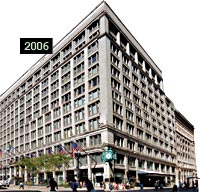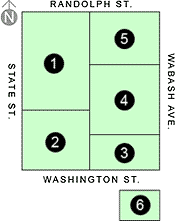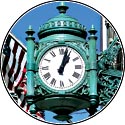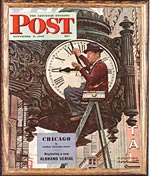On September 9th, when Federated Department Stores slaps the Macy’s moniker on Chicago’s celebrated (and self-styled) “Cathedral of All Stores,” the Field’s name will disappear from the city’s retail landscape after a presence that extended across three centuries. But change has always been part of Field’s history, as a close look at its famous State Street store attests.
 |
  |
Although the store appears to be one building, it is actually made up of five different structures, which have been seamlessly integrated into a single entity. Field’s opened on State (at Washington Street) in 1868. After the great fire of 1871 destroyed that first building, Field’s settled into the Singer Building (also at State and Washington) in 1873. Then, when an 1877 fire consumed that building, a second Singer Building opened (with Field’s as a tenant) in 1879. In 1902, Daniel Burnham’s 13-story Beaux-Arts building went up next door (at State and Randolph) [1]; its near-identical mate to the south (replacing the second Singer Building) followed in 1907 [2]. On the Wabash Avenue side of Field’s, the oldest part of the present store (originally called the Annex) went up at the northwest corner of Wabash and Washington in 1893 [3]. Two other Wabash buildings were added in 1906 [4] and in 1914 [5]; the latter was the same year Field’s 20-story Men’s Store (a mix of retail and office space) opened on the southwest corner of Wabash and Washington [6]. |
|
|
| The two Field’s clocks weigh about seven and a half tons each and were designed by Burnham’s firm. The roman numeral IV (four) is rendered as “IIII,” most likely to eliminate any confusion with VI (six). |  |
Did You Know…
The four 50-foot-tall Ionic granite columns on Field’s State Street façade are rivaled only by the 70-foot-tall columns at Egypt’s 3,000-year-old Temple of Karnak.
The name change (to Macy’s) will not be the first for Field’s, which began business-on Lake Street, in 1852-as P. Palmer & Co. It was subsequently known as Field, Palmer & Leiter (1868), Field, Leiter & Co. (1873), and finally Marshall Field & Company (1881).
After the northeast corner of State and Washington became a popular meeting place, people began leaving notes for one another on the Field’s windows, much to Marshall Field’s displeasure. To end this practice, and encourage punctuality, he erected a clock on the second Singer Building in 1897.
 |
For the November 3, 1945, cover of The Saturday Evening Post, Norman Rockwell painted a man perched atop a ladder and adjusting the large Field’s clock to correspond with his own pocket watch. Rockwell donated the original painting, called The Clock Mender, to Field’s in 1948, and it hung for years on the store’s seventh floor. But after Target Co. sold Field’s to Federated in 2005, the new owners discovered that the painting then on display was actually a reproduction. Federated removed the fake and asked Target to return the original. The dispute has yet to be resolved.
Photography: courtesy of Marshall Field’s



